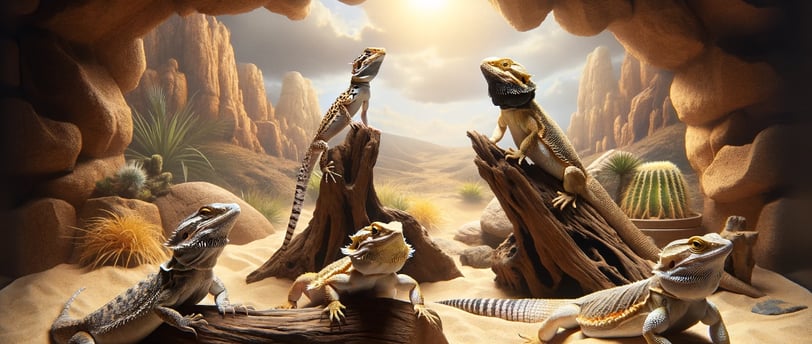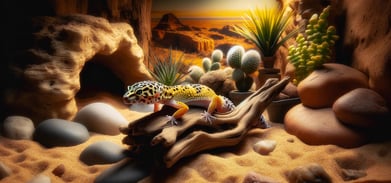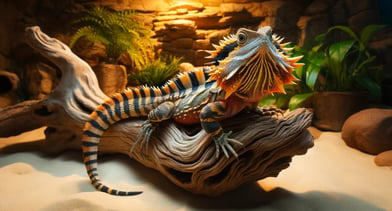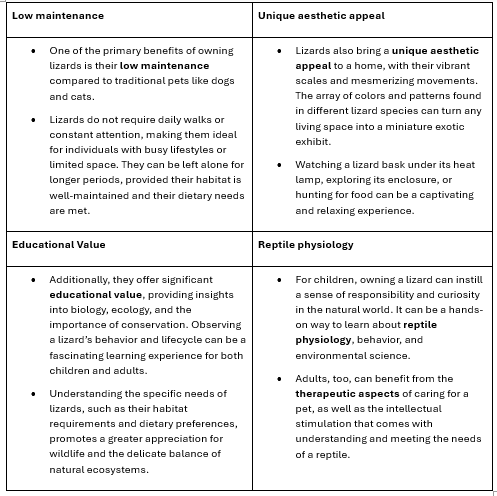Are Lizards Good Pets?
10/25/20245 min read


Are Lizards Good Pets?
Introduction to Lizards as Pets
Are lizards good pets? This question has fascinated people for centuries. Lizards, with their captivating appearance, offer a unique glimpse into a world. It feels ancient and mysterious. Lizards, with their captivating appearance and enigmatic demeanor, have intrigued people for centuries. As potential pets, they offer a unique glimpse into a world that is both ancient and fascinating. The allure of keeping a lizard goes beyond mere aesthetics. Iit encompasses the joy of nurturing a creature that embodies the essence of the wild.
I have a pet lizard named Puff, five goldfish - named Pinky, Brain, Jowels, Pearl and Sandy, an oscar fish named Chef, two pacus, an albino African frog named Whitey, a bonsai tree, four Venus flytraps, a fruit fly farm and sea monkeys ~ Chris Pratt
Popular Pet Lizard Species
Among the myriad of lizard species, several stand out as particularly suited for domestic life.
Bearded dragons
Bearded dragons, known for their docile nature and expressive personalities, are a favorite among reptile enthusiasts.
These lizards are relatively easy to care for and can form strong bonds with their owners,
often recognizing and responding to their caretakers.
Their omnivorous diet makes feeding straightforward, involving a mix of insects, vegetables, and occasional fruits.
Leopard geckos
Leopard geckos, with their striking spotted patterns and manageable size, make excellent pets for beginners.
These nocturnal creatures are low-maintenance and can thrive in simple terrarium setups.
Their diet primarily consists of insects like crickets and mealworms, supplemented with necessary vitamins.
Leopard geckos are known for their calm demeanor, making them a joy to handle and observe.
Frilled dragons
On the more exotic end, frilled dragons and uromastyx offer a more challenging
but equally rewarding experience. Frilled dragons, famous for their dramatic frill display
when threatened or excited, require spacious enclosures and a diet rich in insects.
Their arboreal nature means they thrive in environments that mimic their natural habitat with
plenty of vertical space and branches.
Uromastyx
Uromastyx, also known as spiny-tailed lizards, are desert dwellers that need hot,
dry conditions to flourish. Their diet is primarily herbivorous,
focusing on leafy greens, vegetables, and seeds.
Uromastyx are known for their robust health and interesting behaviors,
such as basking for long periods and digging.
Both species demand a higher level of care and attention to detail,
rewarding dedicated owners with their fascinating behaviors and striking appearances.






Advantages of Owning Lizards


Challenges and Considerations


Environmental and dietary requirements must be met meticulously. Lizards need specific temperatures, humidity levels, and lighting to thrive. This necessitates investment in appropriate equipment, such as heat lamps, UVB lights, and hygrometers.
Their diet varies widely. Some lizards are insectivores, requiring live insects like crickets and mealworms. Others are herbivores, needing fresh vegetables and leafy greens. Providing a balanced diet is crucial. Supplements like calcium and vitamins are often necessary to prevent deficiencies.
Potential health risks must be vigilantly monitored. Metabolic bone disease is common if lizards lack proper UVB light and calcium. Respiratory infections can occur if the habitat is too humid or too cold. Regular vet check-ups are essential to catch and treat illnesses early.
Lizards can live for decades. This demands a long-term commitment from their owners. A bearded dragon, for instance, can live up to 15 years. Leopard geckos and uromastyx can also live for many years, requiring continuous care and attention.
Legal and ethical considerations are also crucial. Some lizard species are protected by law or banned in certain regions. Ensuring that pet lizards are sourced responsibly is vital. This supports conservation efforts and maintains biodiversity. Ethical sourcing means avoiding wild-caught specimens, which can impact natural populations. Always choose captive-bred lizards from reputable breeders.
Owning lizards requires a significant time and financial commitment. It's important to research thoroughly before deciding. Understanding the specific needs of the chosen species is key. This ensures a healthy and happy life for the pet and a rewarding experience for the owner.
Creating the perfect habitat for a lizard involves more than just a tank. A well-designed setup with suitable substrate, hiding spots, and climbing structures is crucial. The substrate should mimic their natural environment. Sand, soil, or reptile carpets are common choices. Hiding spots are essential for lizards. They provide a sense of security. Lizards need places to retreat and feel safe. Hiding spots can be made from rocks, logs, or commercial hide boxes. Climbing structures add enrichment. Branches, rocks, and plants can serve this purpose.
Regular cleaning and maintenance are vital. The enclosure should be spot-cleaned daily. Remove waste and uneaten food promptly. Deep cleaning should be done weekly. Replace the substrate and disinfect the enclosure to prevent disease.
Feeding lizards correctly is crucial. Understanding their dietary preferences is key. Insectivores need live insects like crickets and mealworms. Herbivores require fresh vegetables and leafy greens. A varied diet ensures they receive the necessary nutrients. Commercially prepared diets can be used. These are often fortified with vitamins and minerals. Supplementing with calcium and vitamins is important. This prevents deficiencies and health problems. Dusting insects with calcium powder is a common practice. Herbivores may need supplements added to their food
Health monitoring is another critical aspect. Regular veterinary check-ups are essential. Lizards can hide signs of illness well. Early detection is important for treatment. Monitor for changes in behavior, appetite, and appearance.
Temperature and lighting are crucial for lizard health. Heat lamps and UVB lights are necessary. They help regulate body temperature and support metabolic functions. Different species have specific needs. Researching the correct setup is vital. Humidity levels must be maintained. Use a hygrometer to monitor the environment. Some lizards need high humidity, while others prefer dry conditions. Adjust the setup accordingly with misting or dehumidifying.
Proper hydration is also important. Provide a shallow water dish for drinking. Some species prefer misted water on leaves. Ensure clean, fresh water is always available. Creating a safe and enriching environment takes effort. But it ensures a healthy, happy life for your lizard. Following these guidelines helps meet their needs and enhances their quality of life.
Conclusion
Lizards, with their low maintenance and unique charm, can make fascinating and rewarding pets for those willing to meet their specific care requirements. Their ability to captivate and educate makes them an excellent addition to any household. However, prospective owners must be mindful of the challenges involved, from environmental needs to ethical considerations. With proper care and commitment, lizards can thrive and bring a touch of the wild into our everyday lives.
Essential Care Requirements
A lizard is a perfect pet for a model. They only need feeding once a fortnight. And I'm always traveling, so it's perfect. If I had a dog, it would drop dead of starvation ~ Abbey Lee Kershaw
Blogging
Your go-to platform for top blogging insights.
Connect
Explore
info@blogwaly.com
+92-316-8810243
© 2024. All rights reserved.
